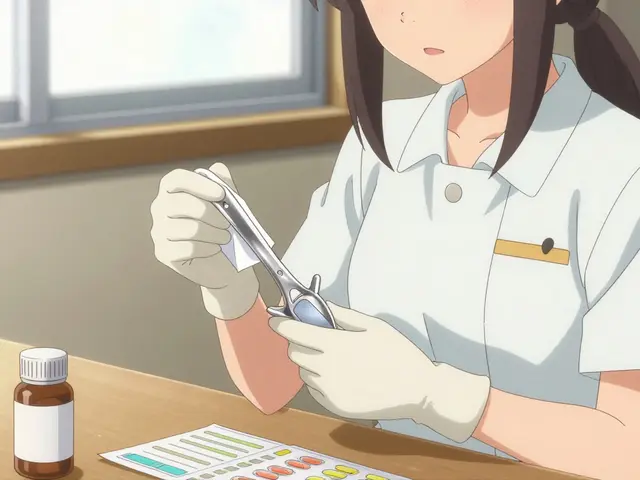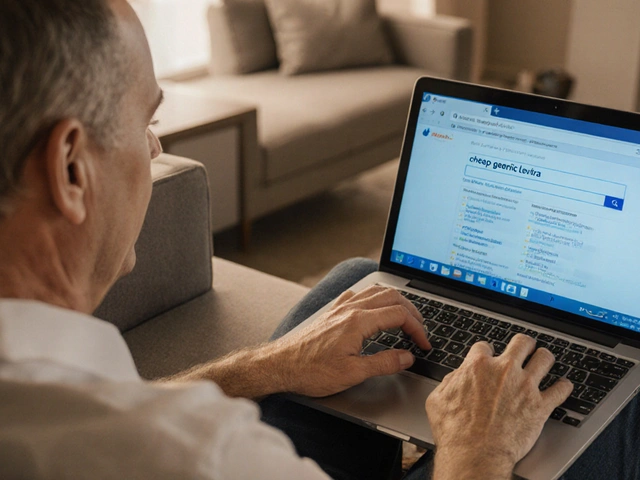
Nausea Severity and Management Calculator
How Severe is Your Nausea?
Rate your nausea on a scale from 1 (mild) to 10 (severe)
Many people start a new medication expecting relief - but end up feeling sick instead. Nausea and vomiting from drugs aren’t just annoying; they can make you skip doses, delay treatment, or even stop taking something life-changing. The truth is, medication nausea is incredibly common. Whether you’re on antibiotics, chemotherapy, painkillers, or even a daily multivitamin, your stomach doesn’t always react kindly. But you don’t have to just suffer through it. There are real, proven ways to prevent and ease these symptoms - and most of them don’t require a prescription.
Why Medications Make You Nauseous
It’s not random. Your body has a system designed to protect you from toxins - and many drugs accidentally trigger it. Medications can irritate your stomach lining directly, especially if taken on an empty stomach. Or they might activate the chemoreceptor trigger zone in your brain, which is wired to respond to chemicals it doesn’t recognize. Some drugs, like chemotherapy agents, send signals straight to the vomiting center in your brainstem. Others, like SSRIs or NSAIDs, affect serotonin levels, which play a big role in gut-brain communication.Not all drugs are equal in causing nausea. Chemotherapy drugs like cisplatin can trigger nausea in up to 80% of patients without treatment. But even everyday meds like ibuprofen, amoxicillin, or iron supplements are common culprits. The worst part? The first few days are usually the hardest. Your body is adjusting, and that’s when nausea hits hardest.
Start with the Simple Stuff: Food and Timing
Before you reach for pills, try the simplest fix: eat. Unless your doctor says otherwise, take your medication with food. A small snack - a cracker, a banana, a slice of toast - can be enough to buffer your stomach. This works especially well for antibiotics, NSAIDs, and multivitamins. Don’t wait until you feel sick to eat. Take your pill right after a light meal, not before bed or first thing in the morning on an empty stomach.Timing matters too. If you’re on an SSRI like sertraline and get dizzy or nauseous during the day, try taking it at night. That way, the side effects hit when you’re already resting. For chemo or other strong meds, your provider might suggest splitting the dose - smaller amounts spread out over the day instead of one big pill. This reduces the shock to your system.
What to Eat (and What to Avoid)
When nausea hits, your stomach doesn’t want spicy, greasy, or sweet foods. These can make things worse. Instead, stick to bland, easy-to-digest options: rice, toast, plain pasta, boiled potatoes, bananas, and applesauce. The BRAT diet (bananas, rice, applesauce, toast) isn’t just for kids - it works for adults too.Carbohydrates are your friend. They settle the stomach better than protein or fat. Try dry cereal, pretzels, or crackers throughout the day. Sip fluids slowly - water, clear broth, or electrolyte drinks. Dehydration makes nausea worse. Don’t chug. Sip every 10-15 minutes. If plain water makes you gag, try adding a slice of lemon or a splash of ginger juice.
Avoid strong smells. Cooking, perfume, smoke, even laundry detergent can trigger nausea. Open a window. Step outside for fresh air. If you’re at home, ask someone else to cook. If you’re in the car, roll down the window. Cold air often helps more than you’d think.

Ginger: A Proven Natural Helper
Ginger isn’t just a kitchen spice - it’s one of the most studied natural remedies for nausea. Multiple studies, including those from cancer support groups, show that ginger reduces nausea severity by 40-60% in people on chemo or other strong meds. It works by calming the gut and blocking serotonin receptors, similar to how some anti-nausea drugs work.You don’t need fancy supplements. Try ginger chews, ginger tea, or even ginger ale made with real ginger (check the label). One patient on Reddit said ginger chews every two hours dropped their nausea from an 8 out of 10 to a 3. That’s not luck - that’s science. Keep a pack in your bag. Take one before your pill, or when you feel the first wave.
When You Need Medicine: Antiemetics Explained
If food, ginger, and rest don’t cut it, there are medications designed specifically to stop nausea. These aren’t one-size-fits-all. Different drugs target different parts of the nausea pathway.5-HT3 blockers like ondansetron (Zofran) and granisetron (Kytril) are the go-to for chemo and surgery-related nausea. They block serotonin in your gut and brain. A single 4-8 mg dose can reduce vomiting by 60-70%. They’re often given IV in hospitals, but oral versions work well at home too.
NK-1 blockers like aprepitant (Emend) and rolapitant (Varubi) are stronger. Used in combination with 5-HT3 blockers and dexamethasone, they can push complete nausea control to 75-85% for chemo patients. These are usually reserved for high-risk cases - like strong chemo regimens - because they’re expensive. Without insurance, one dose can cost $150-$300.
Mirtazapine, an antidepressant, is sometimes used off-label for nausea. At low doses (15-30 mg), it blocks serotonin receptors and helps with sleep - a bonus if nausea keeps you awake. It’s especially useful for post-surgery or chronic nausea.
Tricyclic antidepressants like nortriptyline can help with long-term functional nausea, like from gastroparesis. But they don’t work for everyone. One study found they helped 51% of patients with chronic nausea, but another showed no benefit over placebo. They’re not first-line - but they’re an option if nothing else works.
Behavioral Strategies for Anticipatory Nausea
Some people start feeling sick before they even take their pill. This is called anticipatory nausea. It’s not physical - it’s psychological. Your brain links the sight of your pill bottle, the smell of the hospital, or even the time of day with past vomiting episodes.Medications don’t fix this well. But behavioral techniques do. Deep breathing, guided meditation, and progressive muscle relaxation can interrupt the stress response that triggers nausea. One study showed patients who practiced daily breathing exercises reduced anticipatory nausea by nearly half.
Also, avoid your favorite foods during treatment. If you love pizza but eat it right before chemo and then vomit, your brain will associate pizza with sickness. That’s why cancer support groups recommend eating bland foods during treatment and saving favorites for when you’re feeling better.

When to Call Your Doctor
Nausea is common. But it’s not normal if it’s severe, lasts more than a few days, or leads to dehydration. Call your provider if:- You haven’t kept down fluids for 24 hours
- You’re dizzy, confused, or have a rapid heartbeat
- You’re vomiting blood or material that looks like coffee grounds
- You’ve lost more than 5% of your body weight in a week
- You’re skipping doses because you’re too sick
Don’t stop your meds without talking to your doctor. Sometimes, switching the drug, changing the dose, or adding an antiemetic can solve the problem. But if you’re afraid of cost or side effects, speak up. There are patient assistance programs, generic options, and alternative regimens.
What Not to Do
Don’t rely on home remedies without checking with your provider. Some herbal teas, supplements, or essential oils can interact with your meds. Peppermint oil might help some people, but it can worsen reflux. Alcohol, even a small amount, can increase nausea and interact dangerously with painkillers or antibiotics.Don’t assume it’s “just in your head.” Nausea from meds is real. And don’t wait until it’s unbearable to ask for help. The earlier you act, the easier it is to control.
Final Thoughts: You Have More Control Than You Think
Medication nausea doesn’t have to be part of your daily life. It’s not a sign you’re weak or that the treatment isn’t working. It’s a side effect - and side effects can be managed. Start with food, timing, and ginger. If that’s not enough, talk to your doctor about antiemetics. Use relaxation techniques. Avoid triggers. Keep a simple journal: what you ate, when you took your pill, how you felt. Patterns will show up.You’re not alone. Millions deal with this every year. And with the right tools, you can keep taking your meds - without the sickness.
Can I take my medication with milk to avoid nausea?
It depends on the medication. Milk can interfere with antibiotics like tetracycline or fluoroquinolones by binding to the drug and reducing absorption. For most NSAIDs or SSRIs, a small glass of milk is fine - but water with a snack is safer. Always check the label or ask your pharmacist.
Is it safe to use ginger with chemotherapy?
Yes, ginger is generally safe with chemo and is often recommended by oncology teams. Studies show it reduces nausea without interfering with treatment. Stick to ginger chews, tea, or capsules labeled for medicinal use. Avoid large doses (over 4 grams per day) unless approved by your doctor.
Why do some people get nausea from pills but others don’t?
Genetics, stomach sensitivity, age, and even gut bacteria play a role. Some people metabolize drugs faster or slower, which affects how much hits the bloodstream. Women are more likely to experience nausea from meds than men. Older adults and those with existing digestive issues also have higher risk. It’s not just luck - it’s biology.
Can anti-nausea meds cause side effects too?
Yes. Ondansetron can cause headaches or constipation. Aprepitant may cause fatigue or dizziness. Mirtazapine can make you sleepy or increase appetite. Tricyclics carry risks like dry mouth, dizziness, or heart rhythm changes. But these side effects are usually mild and far less disruptive than constant vomiting. Your doctor will pick the one with the best balance for you.
What if I can’t afford anti-nausea medication?
Talk to your pharmacist or oncology social worker. Many drug manufacturers offer patient assistance programs. Generic ondansetron is available and costs under $10 for a 3-day supply. Some clinics provide free samples. Never skip your main medication because you can’t afford the antiemetic - there are always alternatives.
Next steps: Keep a 3-day nausea log. Note the time you take each pill, what you ate, your nausea level (1-10), and what helped. Bring it to your next appointment. You’ll be surprised how much this changes your treatment plan.





Comments (8)
Abigail Chrisma
I took my antibiotics with a banana last week and my stomach finally stopped rebelling. Seriously, such a simple fix. I used to skip doses because I’d puke right after, but now I eat something light first and it’s like night and day. No magic pills needed.
Also, ginger chews are my new BFF. Keep ‘em in my purse, wallet, even my car. One before every pill. Game changer.
Ankit Yadav
Food timing is everything. I take my SSRIs at night now and the dizziness doesn’t wreck my workday. Also ginger tea > pills. No side effects. Just calm. Why do people still reach for Zofran first?
Simple stuff works. Don’t overcomplicate it.
Meghan Rose
Okay but have you tried peppermint oil? I swear it’s better than ginger. I dab a drop on my wrist and inhale when I feel it coming. And I don’t mean that cheap grocery store stuff-I use the therapeutic grade. Also, don’t even get me started on how bad ginger ale is unless it’s made with real ginger. Most brands are just sugar water with artificial flavor. And milk? No. Never milk. It binds to everything. I learned this the hard way after vomiting for three days because I took my doxycycline with yogurt. Idiot move. You’re welcome.
Also, if you’re on chemo and still using ginger, you’re doing it wrong. You need at least 1 gram per dose. Not some tiny chew. Real science here.
Steve Phillips
Oh. My. GOD. Someone finally wrote this without sounding like a pharmaceutical brochure! I’ve been screaming into the void for years-ginger isn’t ‘alternative medicine,’ it’s a serotonin modulator with a 40-year clinical track record! And yet, doctors still act like it’s witchcraft.
And don’t even get me started on the fact that people think ‘anti-nausea meds’ are a one-size-fits-all solution? Ondansetron? Sure, if you want a headache and constipation that feels like your colon was replaced with concrete. Mirtazapine? Now THAT’S the secret weapon-sleep AND nausea control? That’s not a drug-that’s a goddamn upgrade to your human OS.
And why is no one talking about the fact that anticipatory nausea is literally PTSD from your own body? We treat cancer like it’s a math problem, not a psychological trauma. I’m crying. I’m so proud of this post. Someone get this man a Nobel.
Also-NO ONE USES MILK. EVER. I’m sorry, but if you’re taking tetracycline with yogurt, you’re not a patient-you’re a cautionary tale. With a side of antibiotic resistance.
Rachel Puno
You got this. Seriously. I was on chemo last year and thought I was gonna quit because I couldn’t keep anything down. Then I started the ginger chews and the BRAT diet and kept a little journal like the post said. Two weeks later I was laughing at how much I used to stress over it. It’s not about being strong-it’s about being smart. Small changes. Big results. You’re not alone. I believe in you. 💪
Also, drink water slowly. Like, s-l-o-w-l-y. Chugging makes it worse. Trust me.
Clyde Verdin Jr
So let me get this straight… you’re telling me the solution to nausea is… EATING? And GINGER? And NOT DRINKING MILK?!
Bro. I’ve been on 8 different meds in the last 6 months and every single time I thought I was dying. Turns out I just needed to… not be an idiot?
😭 I feel so seen. And also so dumb. Why didn’t anyone tell me this before? I spent $1,200 on Zofran and all I needed was a banana. 😭🙏
Also I cried reading this. I’m not okay.
Key Davis
While the advice provided herein is both practical and grounded in empirical evidence, I would respectfully suggest that further consideration be given to the pharmacokinetic variability among populations, particularly in regard to cytochrome P450 enzyme polymorphisms, which significantly influence drug metabolism and subsequent gastrointestinal adverse effects. Additionally, while ginger demonstrates efficacy in multiple randomized controlled trials, its bioavailability is highly dependent on formulation-capsules standardized to 5% gingerols are superior to aqueous extracts. Furthermore, the recommendation to avoid milk in the context of tetracycline antibiotics is well-established; however, the broader assertion that milk universally exacerbates nausea is not substantiated by the literature. In fact, for certain proton-pump inhibitor regimens, milk may serve as a protective buffer. Therefore, while the general guidance is sound, individualized medical consultation remains paramount.
- Key Davis, PharmD, Clinical Pharmacologist
Cris Ceceris
I wonder if the reason some people react so badly to meds isn’t just biology… but also how disconnected we are from our bodies. We swallow pills like they’re candy and never pause to think about what’s happening inside. Like, we don’t even notice the first whisper of nausea until it’s a scream.
What if we treated our stomachs like they’re part of us-not just a delivery system for drugs? Maybe if we paid attention earlier-ate slower, breathed deeper, noticed the tension in our shoulders before the pill even hit our tongue-we could stop the wave before it starts.
Ginger helps. Food helps. But maybe the real fix is learning to listen. Not just to the pill, but to the person taking it.
Just thinking out loud. I’ve been on a lot of meds. I know how easy it is to forget you’re still human in the middle of treatment.